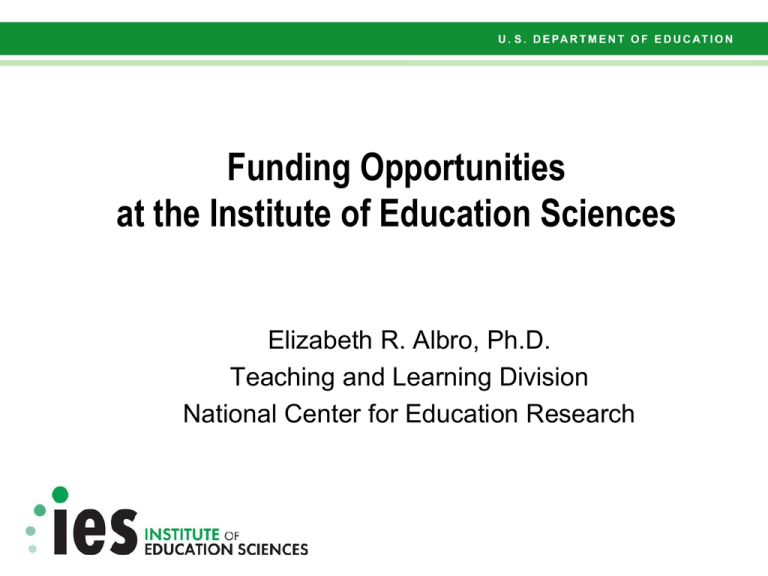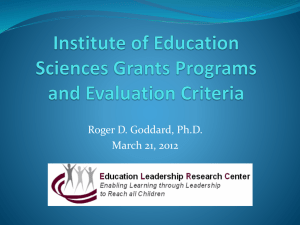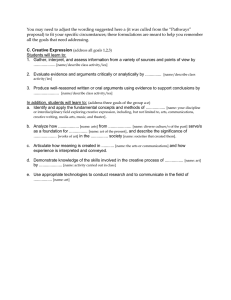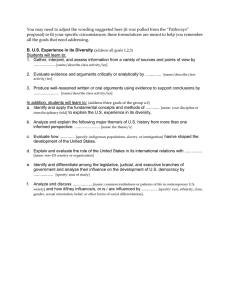Funding Opportunities at the Institute of Education Sciences Elizabeth R. Albro, Ph.D.
advertisement

Funding Opportunities at the Institute of Education Sciences Elizabeth R. Albro, Ph.D. Teaching and Learning Division National Center for Education Research Legislative Mission • Describe the condition and progress of education in the United States • Identify education practices that improve academic achievement and access to education opportunities • Evaluate the effectiveness of Federal and other education programs Organizational Structure Office of the Director National Center for Education Research National Center for Education Statistics National Board for Education Sciences National Center for Education Evaluation National Center for Special Ed Research Getting Started http://ies.ed.gov Required Materials Request for Applications IES Grants.gov Application Submission Guide Application Package Finding Required Materials Fiscal year (FY) 2011 Requests for Applications and the IES Grants.gov Application Submission Guide are available on: http://ies.ed.gov/funding Application Package can be downloaded from http://grants.gov. FY 2011 Research and Research Training Grant Programs Notice Inviting Applications for New Awards published in Federal Register February 4, 2010 Research and Research Training Grant Programs • Education and Special Education Research Grant Programs • Postdoctoral Research Training Grant Programs • National Research and Development Centers • Statistical and Research Methodology in Education • Evaluation of State and Local Education Programs and Policies Identify Appropriate Grant Program • Read the Request for Applications • Check the announced topics • Look at the abstracts of projects funded under a research topic – http://ies.ed.gov/ncer/projects/ – http://ies.ed.gov/ncser/projects/ Education Research Grant Program (84.305A) Special Education Research Grant Program (84.324A) NCER Research Topics • • • • • • • • Reading and Writing Mathematics and Science Education Cognition and Student Learning Teacher Quality – Reading and Writing Teacher Quality – Mathematics and Science Social and Behavioral Context for Academic Learning Education Leadership Education Policy, Finance, and Systems NCER Research Topics (cont.) • Organization and Management of Schools & Districts • Analysis of Longitudinal Data to Support State & Local Education Reform • Early Learning Programs and Policies • English Learners • Postsecondary Education • Adult Education • Education Technology NCSER Research Topics • Early Intervention and Early Learning in Special Education • Reading, Writing, and Language Development • Mathematics and Science Education • Social and Behavioral Outcomes to Support Learning • Transition Outcomes for Special Education Secondary Students NCSER Research Topics (cont.) • Cognition and Student Learning in Special Education • Professional Development for Teachers and Related Service Providers • Special Education Policy, Finance, and Systems • Autism Spectrum Disorders Which Goal Is Right for You? FY2011 Research Goals • • • • • Exploration Development & Innovation Efficacy and Replication Scale-Up Evaluation Measurement Exploration Explore education programs, practices, and malleable factors that are associated with better student learning and achievement outcomes Possible methodological approaches include: – Secondary analyses of longitudinal datasets – Small descriptive studies – Meta-analyses Exploration • $100,000 to $400,000 per year total cost (direct + indirect) • 2 to 4 years Development and Innovation • Develop new interventions (e.g., instructional practices, curricula, teacher professional development) • Demonstrate the feasibility of the intervention for implementation in an authentic education delivery setting • Collect pilot data on promise of intervention to achieve intended outcomes Development and Innovation • $150,000 to $500,000 per year (total cost) • 1 to 3 years Efficacy and Replication • Test whether or not fully developed interventions are effective under specified conditions and with specific types of students. • Studies using random assignment to intervention and comparison conditions are preferred where feasible. • New this year: Efficacy follow-up studies Efficacy and Replication • $250,000 to $750,000 per year (total cost) • Up to 4 years • For Efficacy Follow-Up studies: – $150,000 to $400,000 per year (total cost) – Up to 3 years Scale-up Evaluation • Test whether interventions are effective when implemented under typical conditions. • As implemented by practitioners and with sufficiently diverse samples to support generalizability. • Studies using randomized assignment to treatment and comparison conditions are preferred whenever they are feasible. • New this year: Scale-up follow-up studies Scale-up Evaluation • $500,000 to $1,200,000 per year (total cost) • Up to 5 years • For Scale-Up follow-up studies: – $250,000 to $600,000 per year (total cost) – Up to 3 years Measurement • Develop and validate assessments or other measurement tools • $150,000 to $400,000 per year (total cost) • Up to 4 years What If My Program Is “Between” Goals? PICK ONE! • Read the Request for Applications • Don’t just go for the largest amount of money • Break the project down into smaller pieces • Aim for a well-crafted project that will deliver what it promises Additional Research Grant Programs National Research and Development Centers (84.305C) TOPIC 1: Cognition and Adult Literacy TOPIC 2: State and Local Education Policy TOPIC 3: Postsecondary Education and Employment Cognition and Adult Literacy R&D Center • Explore underlying cognitive processes • Develop and evaluate interventions for adult learners • Specify population (ABE, ASE, Adult ESL) • Can include, as focus of research, one or all of the following: reading, writing, and numeracy State and Local Policy R&D Center • Examine specific state or district education policies relevant to improving education outcomes for students in any grades prekindergarten-Grade 12 • Expect collaboration between researchers and state or district leaders Postsecondary Education and Employment R&D Center • Support state and researcher partnerships to – identify state education longitudinal databases that include or can be linked to longitudinal student postsecondary data and employment or workforce data. – link and carry out analyses using these datasets. – answer research questions examining relationships between postsecondary education and employment outcomes. National R&D Centers in Special Education TOPIC 1: School-Based Interventions for Secondary Students with Autism Spectrum Disorders TOPIC 2: Assessment and Accountability TOPIC 3: Reading Instruction for Deaf and Hard of Hearing Students TOPIC 4: Working Memory Interventions for Students with Disabilities School-Based Interventions for Secondary Students With Autism Spectrum Disorders • Develop, or modify an existing, school-based intervention to address multiple student outcomes for students with ASD in middle or high school • Conduct an efficacy study of the impact of the intervention on student outcomes. Assessment and Accountability • Conduct research on the natural developmental progress in achievement by students with disabilities • Develop and test various approaches for measuring growth for students with disabilities intended for use by school systems for accountability purposes. Reading Instruction for Deaf and Hard of Hearing Students • Explore underlying factors that impede reading and language skills of young students (kindergarten through Grade 2) who are deaf or hard of hearing for the purpose of identifying possible targets for intervention • Develop and test innovative instructional approaches or other interventions for students who are deaf or hard of hearing that utilize research on these underlying factors Working Memory Interventions for Students with Disabilities • Develop and test interventions for students with or at risk for disabilities who have working memory deficits • Interventions focused on improving learning of academic content directly (e.g., reducing length and complexity of instructions or information) or to enhance cognitive functioning in ways that will improve learning of academic content For all Centers • Typical awards are $1,000,000 to $2,000,000 (total cost = direct + indirect) per year for 5 years • Application due date is September 16, 2010 Evaluation of State and Local Education Programs and Policies (84.305E) • Support for rigorous evaluations of education programs or policies that are implemented by state or local education agencies • Typical awards for projects will be $500,000 to $1,200,000 (total cost = direct + indirect costs) per year for a maximum of 5 years Before Beginning to Write • Revisit your research question(s) • Consider who needs to be on your team • Consider what resources you need to have in order to complete the proposed study Before Beginning to Write • Revisit your research question(s) • Consider who needs to be on your team • Consider what resources you need to have in order to complete the proposed study Personnel Considerations • Think about the type of expertise that is needed to carry out the project Build a Good Team • Consider goal and RFA requirements • Consider training and experience • Consider time needed to competently implement the proposed research • Things to consider for junior researchers or those without a track record of large projects and grants Things to Consider • Challenge—convince reviewers that you (and your team) have the skills and experience to implement well what you have proposed • Develop a team • Demonstrate productivity Next Steps • Read appropriate Request for Applications closely one more time and confirm that your idea fits the requirements for a specific Topic (e.g., Math and Science) and Goal • Contact the appropriate program officer and discuss your project with him or her Recap • Select RFA • Select Topic within RFA • Select Goal within Topic • Begin to identify Key Personnel • Contact NCER or NCSER program officer(s) Preparing the Application (Complete all components) Preparing the Application • SF 424 (R&R) (Cover Sheet) • Research and Related Budget (Total Federal and Non-Federal) form • Project Summary/Abstract • Contents of the Application Preparing the Application: Contents • Project Narrative • Bibliography and References Cited • Biographical Sketches of Key Project Personnel • Narrative Budget Justification • Sub-award Budgets Preparing the Application: Contents • Appendix A (letters of agreement; tables; figures) • Appendix B (curriculum materials) • Additional forms for applicants selected for funding Preparing the Application: Creating a Budget • • • • Personnel Fringe Benefits Travel Equipment • • • • Supplies Contractual Other Indirect Costs Preparing the Project Narrative Project Narrative • Significance • Research Plan • Personnel • Resources Significance • Read the RFA • Information required to address significance of project depends on the Research Goal Research Plan • Read the RFA • Information required of the research plan depends on the Research Goal Designing Projects Under Each Goal: Research Plan Designing Exploration Projects Secondary Data • Choose a pre-existing dataset (local, district, state, national) • Explain characteristics of dataset well • Provide sufficient detail as to the statistical and analytic plans you will use to draw conclusions • You may propose to collect additional data Designing Exploration Projects Primary Data • Clearly describe the sample • Explain the measures and how the data are coded in sufficient detail so that the relation between measures and hypotheses are clear • Provide detailed statistical and analytic plans Designing Exploration Projects Meta-analysis • Clearly describe – Criteria for including studies and rationale – Search procedures – Coding scheme and procedures for extracting data – Procedures for ensuring reliability of coding • Demonstrate sufficient numbers of studies available • Provide detailed statistical and analytic plans including defining effect size statistics Designing Development and Innovation Projects FY 2011 IES Development and Innovation Projects • End product is a fully developed intervention • Pilot data on the feasibility of implementing the intervention in schools • Pilot data on the promise of the intervention for generating desired outcomes Why Develop This Intervention? • Context for the proposed intervention – – – • Describe the proposed intervention – – – • Describe attributes of existing practice Specify shortcomings of existing practice Clarify the problem What are the components or features of intervention? Who will implement or use it? How will it be used? Practical importance of the proposed intervention Why Develop This Intervention? • Theory of change – What is the causal chain of events that leads from the implementation of the intervention to the desired outcome? • Rationale for theory of change – Theoretical and empirical justification – How does the proposed intervention address the shortcomings of current practice? Development (Research) Plan • What will be developed? • How will it be developed? • How will the intervention (components) be tested to see if it operates as intended? “Operating as Intended” • Define “operating as intended” • What data will be collected to determine how the intervention is operating? • How will the data be used to revise the intervention, if needed? Iterations???? • Number of iterations depends on the complexity of the intervention and its implementation Feasibility of Intervention • Demonstrate that intervention can be implemented with fidelity – In settings that represent the type of settings for which the intervention is intended – By users who are like those for whom the product is intended Promise of the Intervention • Does performance on outcome measures progress in the appropriate direction? • Is implementation of intervention associated with changes in activities and behaviors that are consistent with the theory of change? Designing Efficacy and Replication Projects • Goal is to determine whether or not fullydeveloped interventions—programs, practices, policies—are effective – Under specified conditions (e.g., urban schools with high teacher turnover rate) – With specific types of students (e.g., students with reading disabilities) Designing Efficacy and Replication Projects • Describe the components of the intervention • Describe how the intervention differs from what is typically offered in education settings • Define your sample well Designing Efficacy and Replication Projects • Prefer use of random assignment • Decide level of randomization (student, teacher, school) • Ensure that level of randomization matches level of analysis Designing Efficacy and Replication Projects • Use power analysis to determine number of students, teachers, schools needed to draw conclusions about impact • Include standardized measures of student achievement • Attend to fidelity of implementation Designing Scale-up Evaluations • Does this intervention produce a net positive increase in student learning and achievement relative to the variety of products or practices that are currently available and utilized by schools? Designing Scale-up Evaluations • All of the methodological requirements for Efficacy and Replication projects • Implementation occurs at scale and under typical conditions Designing Scale-up Evaluations • Choosing Outcome Measures – Do they map well onto your theoretical questions? – Are you using standardized achievement tests? – Have you included proximal measures? – Who will administer them? – Did you budget to buy them? Designing Measurement Projects • Provide strong theoretical rationale for development of new measurement tool • Justify the need for this new tool • Detail the proposed procedures for developing the assessment instrument • Describe the research plans for determining the validity and reliability of the instrument Designing Measurement Projects • Describe the characteristics and size of samples to be used in each study • Explain procedures for collecting data • Describe additional measures to be used to determine validity of new tool • Describe data analytic strategies Personnel and Resources • Read the RFA • Don’t forget to address these two sections within the project narrative Personnel • Include section in narrative, specify all key personnel • Summarize relevant experience • Specify role on this project and percentage of effort devoted to project • Use biographical sketches (CVs) to further document expertise and productivity Resources • Include section in narrative, describe resources available to support completion of the project • In Appendix A document access to schools or datasets needed to conduct research project Build Relationships With Schools Include Letters of Agreement • Expected for most competitions • Reviewers look for them and read them carefully • Should include detailed information that demonstrates that your partners understand what participation will entail • From whom should you get letters? – Teachers, Principals, District? Formatting Requirements • Abstract is 1 page single-spaced • Research narrative is no longer than 25 pages single-spaced • Bibliography has no page limit • Each biographical sketch is limited to 4 pages • Budget justification has no page limit • Appendix A can be no longer than 15 pages • Appendix B can be no longer than 10 pages Additional Reminders • Pay attention to what can and cannot be included in the appendices • Have a colleague who isn’t involved in the project read a draft Letters of Intent and Application Due Dates • Applications are accepted twice a year – June 24, 2010 - PAST – September 16, 2010 • Letters of Intent are important, but not required Finding Application Packages • FY 2011 Application Packages are available on www.grants.gov Reviewers’ Perspectives • Write clearly and concisely • Address the points described in the RFA • Organize information in logical sequence • Label sections and number pages • Make it easy for reviewers to find and understand the information Submitting a Proposal • All proposals must be submitted electronically to http://www.grants.gov • By 4:30 p.m. Washington, DC, time on September 16, 2010 Final Proposal Submission • Online forms are complete • PDFs of proposal contents have been uploaded • Authorized representative has completed the final step of the electronic process • You have received e-mail acknowledging receipt of your application What Happens Next? Peer Review • Application is reviewed for compliance • Compliant applications are assigned to a review panel • Two or three panel members conduct primary review of each application • At panel meeting, the most competitive applications are reviewed by full panel Peer Review Process Information http://ies.ed.gov/director/sro/peer_review/index.asp Notification • All applicants will receive e-mail notification of the status of their application • All applicants receive copies of reviewer comments • If you are not granted an award the first time, plan on resubmitting and talk to your program officer http://ies.ed.gov/resourcesforresearchers.asp Final Reminders Don’t Forget... • Start early • Read the Request for Applications • Talk with the program officer • Start the online submission process early Help Us Help You • Read the Request for Applications carefully. • Call or email IES program officers early in the process. • IES program staff can review draft proposals, and provide feedback. Don’t be afraid to contact us! http://ies.ed.gov/funding Elizabeth Albro elizabeth.albro@ed.gov




